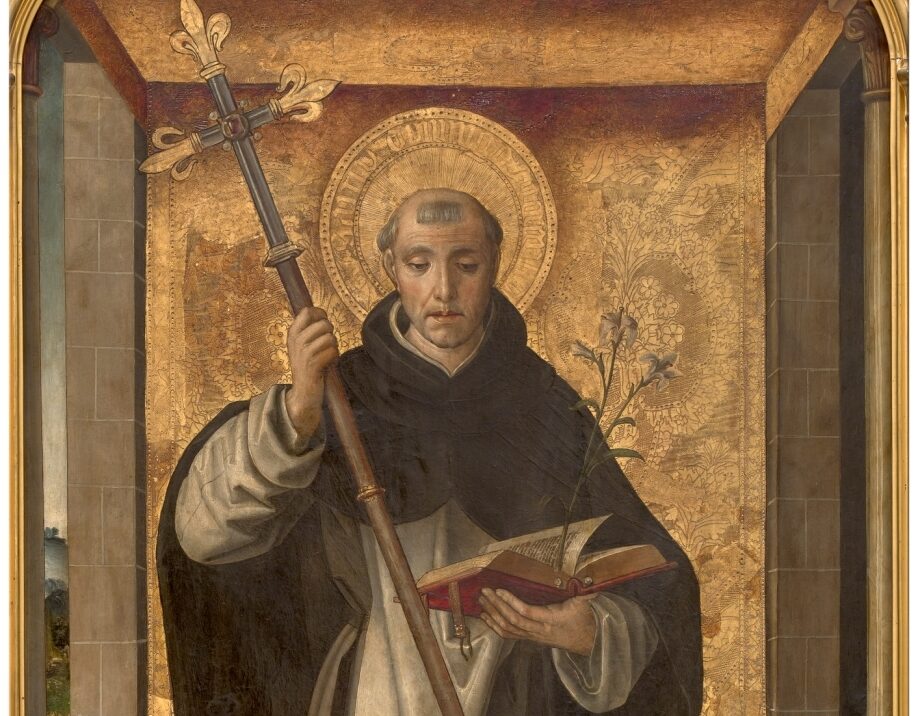St. Dominic of Guzman is one of the great holy priests of the Middle Ages. He was born around 1172 in Caleruega (Burgos). At the age of fourteen he went to study Liberal Arts and Sacred Scripture at the University of Palencia. There he manifested his charity towards the poor, for during a period of terrible famine, he sold his books to give the money obtained to the poor. This meant parting with valuable codices, painstakingly collected during years of laborious study, giving up a patrimony that would be almost impossible to rebuild later.
His beginnings in the priesthood
He was ordained a priest at the age of 25, forming part of the chapter of canons regular of the cathedral of Osma (Soria). In 1203 he accompanied his bishop, Diego de Acebes, on a delicate mission to arrange the marriage of the son of King Alfonso VIII of Castile with a Danish princess. On their return from Denmark, in 1206, they met in the French city of Montpellier the papal legates, Pedro de Castelnau and Raul de Fontroide, sent by the Pope to repress the heresy of the Cathars or Albigensians, and convinced them that for their preaching to be effective, they had to give an example of evangelical poverty and renounce the ostentatious luxury they displayed. The bishop and Dominic stayed in the south of France to preach against this heresy.
The Order of Preachers
Bishop Diego soon returned to his diocese to recruit new preachers and died there in 1207, so Dominic had to continue the preaching work by himself, but soon after he was joined by a group of priests, attracted by his evangelical ideal. In 1215 he founded his first religious house in Toulouse with his first two disciples, who joined him by religious profession to form a community. The same year the bishop of the diocese, Folco, officially approved it, which represents the origin of the Order of Preachers. The next step was to obtain pontifical approval, since at that time the only institutionalized preachers were bishops. To this end he accompanied Bishop Folco to Rome for the Fourth Lateran Council (1215), and there he met Pope Innocent III, who encouraged him to put into practice his program of religious and pastoral life. In 1216 he returned to Rome, where Pope Honorius III definitively approved the new Order of Preachers.
In 1218 the two main convents of the Order were founded, the one in Paris and the one in Bologna, since these two cities were the main centers of the culture of the time. The General Chapter of 1220 confirmed the election of Dominic as Superior General, who in the Dominicans is called "Master of the Order", a position he held until a few months before his death. The last year of his life was dedicated, by order of the Pope, to organize two convents in Rome, one for nuns, San Sisto, and another for friars, Santa Sabina, which later became the generalate house of the Order.
Death and spiritual legacy
He died on August 6, 1221 in Bologna. Shortly before his death he said to his spiritual children: "Do not weep; I will be more useful to you and bear more fruit for you after my death than with all that I have done in my life." He was canonized by Gregory IX in 1234. His contemporaries present St. Dominic as a man of deep prayer, with a phrase that has become a classic: "He only talked to God or about God."
No work of his has been preserved. Of his correspondence, which must have been numerous, only a letter in Latin to the Dominican nuns of Madrid has come down to us.
St. Dominic's personal spirituality is transmitted through his foundational charism to the Order of Preachers. As George Bernanos writes: "If we could raise a single and pure gaze on the works of God, this Order would appear to us as the very charity of St. Dominic, realized in space and time, as if his prayer had become visible."
The desire for the salvation of souls
This spirituality is characterized by the common end, which consists in the desire for the salvation of souls. This requires a specific end, preaching, which is subordinate to the previous one. The preacher gives to others the treasure he has accumulated in contemplation. This is the fundamental difference between the Order of Preachers and the previous monastic Orders, which "spoke to God" and often "of God", but did not have a directly apostolic orientation, but their specific end was the contemplative life. In the Order of Preachers, on the other hand, the apostolic end is placed at the same level as the contemplative end. Later St. Thomas Aquinas would summarize this fact with the phrase: Contemplata aliis tradereto give to others the fruit of one's contemplation.
If the common end of the Order of Preachers is the salvation of souls and its specific end is preaching, the indispensable means to reach both ends is the assiduous study of the Sacred Sciences, which replaced the manual work of the monks in the Orders previous to that of St. Dominic. Study constitutes the dominant passion of this Order. The liturgy defines the saint as Doctor Veritatis, y Veritas is the motto of the Order of Preachers.








